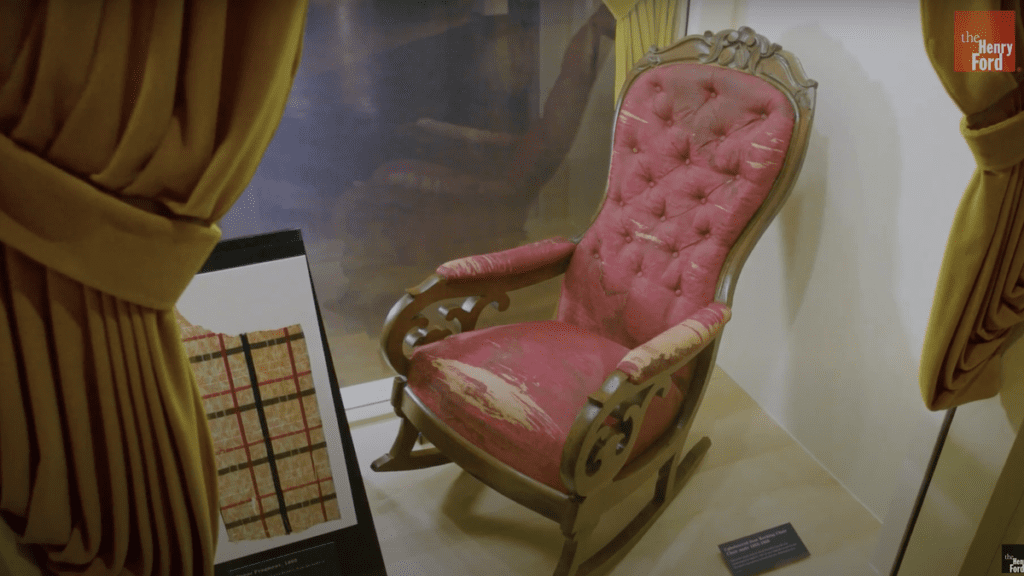How Henry Ford Ended Up With Abraham Lincoln's Assassination Chair

Despite our complicated views on the man himself, I absolutely love the museum Henry Ford built in his hometown of Dearborn, Michigan. Aptly named the Henry Ford, it’s full of not just amazing cars and machinery, but little bits of history you wouldn’t normally find in your average car museum. Along with a vial of Thomas Edison’s final breath and the oldest surviving school bus in America is the chair President Abraham Lincoln sat in when John Wilkes Booth walked into Ford’s Theater and assassinated the president.
The Lincoln Rocker sits on the museum floor near another iconic piece of history, the bus that was the site of Rosa Parks’s famous act of defiance in 1955. The bus makes much more sense in the museum, since it is a vehicle. But why the chair? To understand how the Lincoln Rocker came into the museum’s possession, you have to know a little bit about Henry Ford and the grounds just outside his monument to industrial history.
The facility is partially an enclosed museum dedicated to American life and ingenuity, but that mission is also carried out on the grounds of the adjacent Greenfield Village. The Village is 80 acres of recreated bits of historic America. It features a working farm, craftspeople making items as they did in the “good old days” and historic buildings from every era. And it was all dictated and decided on by Ford himself. For instance, Thomas Edison’s actual workshop was disassembled piece by piece, trucked up and recreated in Michigan. Ford saw Edison as an inspiration, a mentor and, finally, a friend. Which is how a vial of Edison’s last breath also came to reside in the museum.
Ford also felt inspired by another great American: Our 16th president, Abraham Lincoln. He bought the Logan County Courthouse where a young Abraham Lincoln once practiced law. Like Edison’s workshop, it was disassembled and carted up to Dearborn. He intended to turn the entire building into a mini museum dedicated just to Lincoln. When the opportunity to buy the assassination chair came up Ford leapt at the chance.
The chair itself is a simple parlor rocking chair wheeled on to the balcony at Ford’s Theater by management specifically for the president’s comfort. After Lincoln was shot by John Wilkes Booth on April 15, 1865 the chair was held as evidence in the trial of Booth’s co-conspirators. It eventually found its way into the Smithsonian museum’s basement into a secret break room where it was subject to water damage, plaster, dust and random people dragging their greasy hair styles across the silk upholstery for 30 years. The Ford family (the owners of the theater, not the automaker) petitioned in 1927 for the chair’s release back into the family’s hands.
G/O Media may get a commission

save up to 30%
Adidas Holiday Weekend Sale
Build a new wardrobe
Save up to 30% off just about everything Adidas during this sale, including men’s, women’s and children’s styles. That includes T-shirts, hoodies, shorts, sweats, sneakers, socks, and anything else you can think of.
They got the chair back in 1929, and promptly sold it for $2,400—over $41,000 in 2023 dollars—to a dealer Henry Ford hired to fill his museum with interesting pieces. When it arrived in Dearborn in January of 1930 Ford was so thrilled with the purchase that he filmed his crew opening the box:
Unpacking Abraham Lincoln’s Assassination Chair (1929)
Ford housed the rocker in the Logan County Courthouse in Greenfield Village until 1980, when it was moved into the museum proper. In the early 1990s, it was clear the chair was in trouble. Little flecks of silk drifted up from the chair when a stiff breeze passed, according to the museum. Outside cloth-preservation experts took steps to prevent the silk upholstery from degrading any further. Curators also tested the chair and found three human blood samples in the silk, but have no way of knowing to whom the samples belong, MLive reports. The dark stain on the top of the chair is not blood, however, but the aforementioned grease stains from random folks using the chair as a place to chill in the Smithsonian basement. Today, the chair sits in a climate controlled case in a display right next to the Rosa Parks bus. Both pieces serve as stirring reminders of the bravery it takes to beat back deeply entrenched racial divides.
The gruesome reminder of that violent, tumultuous time in America also sits not too far from another visceral piece of presidential assassination history: The 1961 Lincoln Continental where President John F. Kennedy was shot. No longer a convertible, as it remained in service for years after Kennedy’s death, the limo and the rocker are two of the most visited items in the museum, according to curators.



